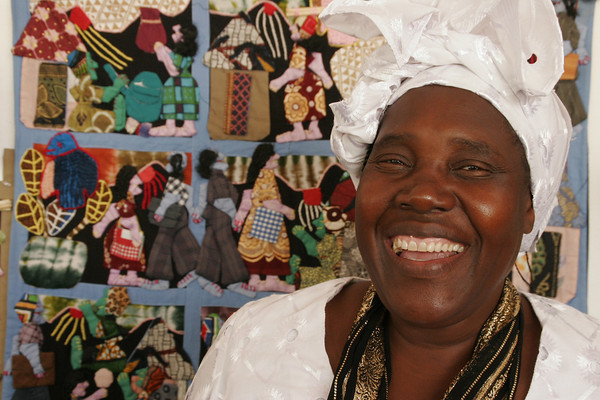
The Santa Fe International Folk Art Market
In conjunction with the July 9-11 Santa Fe International Folk Art Market, the largest market of its kind in the world (now in its seventh year), the Santa Fe Museum of International Folk Art opens Empowering Women: Artisan Cooperatives That Transform Communities July 4th in its new Gallery of Conscience, a space to be dedicated to examining the current issues that “threaten the survival of the traditional arts,” according to museum director Marsha Bol.

Julia Mutale, Basket Artizan from Zambia
This years theme emerged from what guest curator Suzanne Seriff described in the summer issue of El Palacio as a yearlong conversation between the museum and the market, prompted by how many of the applicants to the market are cooperatives, and their stories about the impact of the money they brought back to their communities.
The objective of the show, said Seriff, is to look at the phenomenon of how folk art cooperatives are empowering women to build economically and ecologically sustainable lives in the face of war, genocide, AIDS, and domestic and cultural abuse.
Serriff, a folklorist and University of Texas senior lecturer, selected 10 folk art cooperatives from this years market participants.
With quotes, floor-to-ceiling photo murals of the artists in their communities, and representative pieces of the artists work-a traditional black and white peace basket from Rwanda, an Indian artists own embroidered wedding dress with a photograph of her in it, embroidered story cloths from South Africa that depict contrasting scenes of contemporary and traditional daily life, life with AIDS and crime, as well as life before, a series of hand-dyed and hand-woven baskets from Swaziland, elaborately beaded neck collars from Kenya, hand-carded-and-dyed wool weaving from Peru, bromeliad bags from Bolivia, buttons from Morocco, paintings from Nepal, silk textiles from Lao–the show will present the stories of the making of the work and how the work and the cooperatives are affecting the social and economic lives of their members and their communities as they preserve traditional arts.
The women are survivors-of the 1994 Rwanda genocide in which 1,000,000 people died in 100 days (left: Hutu and Tutsi basketry from Rwanda), of Indian cultures in which women were previously known by only their husbands name, of rapes, beatings and forced marriages, of trying to survive in an agricultural economy in a country where only 4% of the land is arable. Their arts may enable them to thrive.

Hutu and Tutsi basketry from Rwanda
At the market, the largest of its kind in the world, this year 170 master folk artists from 52 countries, among them Cameroon, Ethiopia, Israel, Kazakhstan, Ukraine, Brazil, Haiti, Kenya, India, Lao, Niger, and Uzbekistan, will set up about 100 booths in sight of the Sangre De Cristos to sell their art in the shimmering air. The artists keep 90% of the money from sales. Last years market drew almost 24,000 people, who spent a little less than $2 million to buy work that ranged in price from $5 to tens of thousands of dollars.
Quotes from the show include testaments to the power of expression through art.
When you keep quiet you sign your own death warrant ….If I am sad I put it into my embroideries. If I am happy I express it through the colors of my work. Even if I had a million rand I would not stop doing this work…”
–Maria Rengane, founder of Mapula (Mother of Rain) Embroidery Project,
from her AIDS is NOT a SIN quilt…..in South Africa
“There is a saying in our country that men dont make homesteads, women do… So, if you have an active woman who knows what her role is then you have a home…. ”
–Nurse Thembeni Mduli, founder of Phez, kwemkhono Bomake-Nketa Cooperative, Swaziland
“I have survivors. I have widows. I have women whose husbands are in prison. To see them sitting under one roof weaving and doing business together is a huge achievement….These women are now together earning an income…”
–Janet Nkubana, cofounder Gahaya Links Cooperative, Rwanda.
What is revolutionary, life and village changing, is the interaction with the wider world, the money as well as the cultural exchanges. The value the Western world places on the work, even at its least expensive, can help to build a school or a well or a health clinic or a soup kitchen, or buy food and clothing and medical care in the artists communities where the per capita annual incomes are extremely low.
The exhibit runs through January 2, 2011.
(top photo: Maasai bead artist Agnes Papatiti. Photo: Judith C.Haden)
